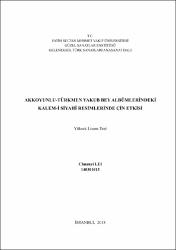Akkoyunlu-Türkmen Yakub Bey Albümlerindeki Kalem-i Siyahî Resimlerinde Çin Etkisi
Künye
LEI, Chuanyi, Akkoyunlu-Türkmen Yakub Bey Albümlerindeki Kalem-i Siyahî Resimlerinde Çin Etkisi, Fatih Sultan Mehmet Vakıf Üniversitesi Lisansüstü Eğitim Enstitüsü Geleneksel Türk Sanatları Anasanat Dalı, Yayımlanmamış Yüksek Lisans Tezi, İstanbul 2019.Özet
Çin resim tarihinde, Sung-Yüan devrinde (11-14. yy.) gelişen Bai-miao isimli çizgisel
mürekkep resim üslubu, Moğollar vasıtasıyla Orta Asya, Batı Asya ve Anadolu coğrafyasına
ulaşmıştır. Çin metropolitan ressamları ve yerel atölyelerdeki sanatkârların ortaya
koydukları resimler ve bunların muhtelif kopyaları, Orta Asya ve İran’da Çin etkisini
yansıtan ve yorumlayan resimler saray albümlerine girmişlerdir.
Topkapı Sarayı Müzesi Kütüphanesinde bulunan H. 2153 ve H. 2160 numaralı iki
nadide albüm ile bunların bir parçası olan Berlin Diez Albümlerinin içeriklerinin çoğu
Akkoyunlu hükümdarı Yâkub Bey’in himayesinde toplanarak hazırlanmıştır. Bunlar
arasında geleneksel minyatüre benzemeyen ve Çin resim sanatı etkisini yansıtan sade
mürekkepli birçok resim, tahrir, bezeme tasarımı içeren ve Kalem-i Siyahî olarak
adlandırılan yeni bir resim çeşidi görülmektedir. Özellikle 14. yüzyılda yaşayan Emîr
Devletyâr, ʿAbdu’l-Hay, Sultan Ahmed Celâyir gibi üstatların Kalem-i Siyahî tekniğiyle
yaptıkları bu çalışmalarda estetik zevk ve sanatsal beslenme ile yeni bir tarz karşımıza
çıkmaktadır.
Bu tezde, günümüze kadar gelen farklı konuları işleyen Kalem-i Siyahî resimlerindeki
Çin etkisi, özellikle Bai-miao ve Şan-Şui teknikleri açısından incelenmektedir. Ayrıca
orijinal Çin kaynaklarının fırça-mürekkep tekniklerinin karşılaştırma yöntemiyle uygulamalı
analizi de yapılmaktadır. Bai-miao painting, which is drawn only by ink lines, highly prospered and
progressed during Sung-Yuan Dynasty from the 11st to the 14th century in Chinese history.
After Mongolians took over the Central Plains of China, this kind of arts began to appear in
the Middle Asian, Western Asian and Anatolian, being brought to the west by the artists
living in the metropolitan cities of China and provincial artists. At that times, some
reproduction paintings and some paintings under the Chinese influence yet with the local
aesthetic taste, which were manufactured in Middle Asian and Iran, eventually came into the
albums of Sultans with original Chinese paintings.
The two albums named H. 2153 and H. 2160 are significant from the other Saray
Albums (TSMK H. 2152, H. 2154, SBB Diez Album) in the Manuscript Library of Topkapi
Palace Museum. Most works of the two albums were ordered to paint or collected under the
protection of Aqqoyunlu-Turkmen Sultan Yâkub Beg. Among these plain linear ink works,
drafts, sketches, and the reflected Chinoiserie effects are so manifested that with the name
of “Qalam-Siyâhi” a new kind of painting art had formed which was totally different from
the traditional Islamic miniatures had formed. Especially, the techniques of the Qalam-
Siyâhi artworks made by masters like Amîr Dawlatyâr, ʿAbdu’ l-Hayy, Sultan Ahmed
Celâyir produced a strong aesthetic value and new artistic nutrition.
In this thesis, the Chinosiserie effects of Qalam-Siyâhi paintings will be studied
through the perspective of the Bai-miao and Shan-Shui painting techniques again.
Furthermore, the comparative study method of the brush-ink techniques is to be used for
analysis.



















